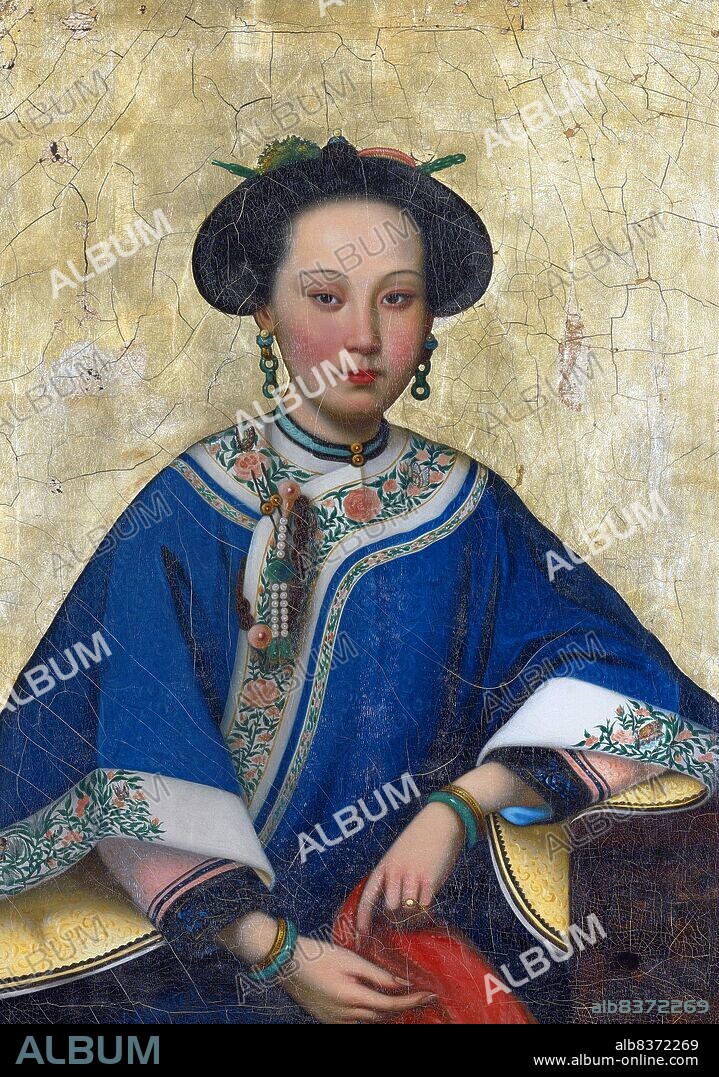alb8372269
China: Consort Rong, 'The Fragrant Concubine' (1734-1788), consort of the Qianlong Emperor. After a painting by Lang Shining (Giuseppe Castiglione,1688-1766), oil on canvas with gilt-foil ground,19th century

|
Add to another lightbox |
|
Add to another lightbox |



Buy this image.
Select the use:

Title:
China: Consort Rong, 'The Fragrant Concubine' (1734-1788), consort of the Qianlong Emperor. After a painting by Lang Shining (Giuseppe Castiglione,1688-1766), oil on canvas with gilt-foil ground,19th century
Caption:
The Fragrant Concubine (Chinese: Xingfi; Uyghur: Iparxan, Khoja Iparhan) is a figure in Chinese legend who was taken as a consort by the Qianlong Emperor during the 18th century. Although the stories about her are believed to be mythical, they may have been based on an actual concubine from western China who entered the harem of the emperor in 1760 and who carried the court title of Rong Fei.
. Some suggest, however, that Imperial Consort Rong (whose original name may have been Maimur Azum) and Imperial Consort Xiang were different women. Han Chinese and Uyghur tellings of the legend of the Fragrant Concubine diverge greatly, and her experience represents a powerful symbol for both peoples. The story became greatly popular during the early 20th century and has since been adapted into several plays, films, and books.
. Some suggest, however, that Imperial Consort Rong (whose original name may have been Maimur Azum) and Imperial Consort Xiang were different women. Han Chinese and Uyghur tellings of the legend of the Fragrant Concubine diverge greatly, and her experience represents a powerful symbol for both peoples. The story became greatly popular during the early 20th century and has since been adapted into several plays, films, and books.
Credit:
Album / Universal Images Group / Pictures From History
Releases:
Model: No - Property: No
Rights questions?
Rights questions?
Image size:
3580 x 5100 px | 52.2 MB
Print size:
30.3 x 43.2 cm | 11.9 x 17.0 in (300 dpi)
Keywords:
18TH CENTURY • 18TH CENTURY, THE • 18TH CENTURY. • 18TH • 19 CENTURY • 19TH CENTURY • 19TH CENTURY. • 19TH • 19TH-CENTURY • ART • ARTS • ASIA • ASIAN • CHINA • CHINE • CHINESE • CONSORT RONG • CONSORT • EMPEROR QIANLONG • EMPRESS • FEMALE • FEMALE. • FEMALES • FRAGRANT CONCUBINE • IMPERIAL CHINA • IPARHAN • LEGEND • MAIMUR AZUM • MANCHU • MANDATE OF HEAVEN • MONARCHY • MUJER • MUSLIM WORLD • NINETEENTH CENTURY • PAINT • PAINTING • PAINTINGS • PORCELAIN • QING • QUEEN • QUEENS • RONG FEI • ROYALTY • RULER • UIGHUR • UYGHUR • WOMAN'S • WOMAN • WOMAN. • WOMANS • WOMEN IN HISTORY • WOMEN'S • WOMEN • WOMENS • XIANG FEI • XINJIANG • XIX CENTURY • XVIII CENTURY
 Pinterest
Pinterest Twitter
Twitter Facebook
Facebook Copy link
Copy link Email
Email
